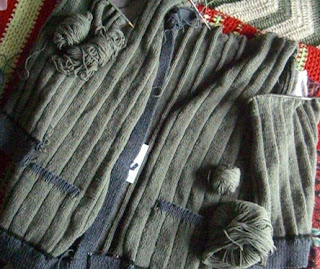Before bookstores had cafes, and certainly before "search inside" a book online, there were libraries. For no money, you could read all the books you wanted, in the comfort of your home, and didn't have to find space for storing all those books.
The bright blue bookmobile, similar to this one,

that appeared every two weeks was a central point of my childhood. Herman Sherman and the library lady let me take home as many books as I could carry, and over the two weeks I'd usually get through them all. (Ah, the vast acres of empty hours of interminable childhood!)
Now that tiny little Pitt Meadows has become a built up suburb, among the shopping centres is the library, a treasure chest including new-to-me Canadian authors, and magazines that can be borrowed. Time for thoughtfully choosing books was limited on that first visit, but I couldn't resist taking "A knitting mystery" home -- unfortunately, a little went a long way, for example on p3:

"Kelly turned to see Burt Palmer, retired cop and now spinner par excellence, grinning as he carried a huge bag of multicolored fleeces into the adjacent room."
Much more promising in terms of literary quality and discerning use of "technical details", and one I'll order on the internet, is
The Girl who Stopped Swimming, which has an art quilter as the central character.
Meanwhile, I have a jolly book bag as a souvenir of all my years of using the Fraser Valley Regional Library.

And the library has a "bestseller express" corner - 7 day loan, $1 a day overdue fine - where I found this and liked the cover:

The central character is a book conservator, and the scene jumps to various historical periods, tracing the history of the manuscript and of the people involved with it. All very thoroughly researched, to the point of overload methinks. I was amused to read of the heroine taking a cab from Hampstead to Westminster because there wouldn't be time to do the journey by underground - even though the congestion charge now makes traffic less gridlocked, going by tube would probably be a better option; on the other hand, Hampstead is on the notorious Northern Line....l
 ok, it sure ain't art - but it's more valuable than the photographs, because some prolonged looking and thinking, and interaction, is involved.
ok, it sure ain't art - but it's more valuable than the photographs, because some prolonged looking and thinking, and interaction, is involved.




































 (How wrong they were!)
(How wrong they were!)


 (The camera has developed intermittent floaters again; I don't have software to clean up the pix.)
(The camera has developed intermittent floaters again; I don't have software to clean up the pix.)
 School photographs in the
School photographs in the  At first many men were sent to work in road camps; some families stayed together by working on sugar beet farms in Alberta, where labour was in short supply. Anyone who resisted internment was rounded up by the RCMP and sent to a barbed-wire prisoner-of-war camp in Ontario. We didn't learn about this when I was in school, but it's taught now.
At first many men were sent to work in road camps; some families stayed together by working on sugar beet farms in Alberta, where labour was in short supply. Anyone who resisted internment was rounded up by the RCMP and sent to a barbed-wire prisoner-of-war camp in Ontario. We didn't learn about this when I was in school, but it's taught now.
